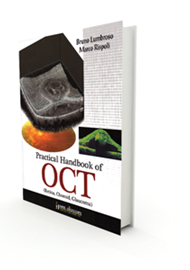With the rapid development and expansion in the usage of optical coherence tomography (OCT) technology there is always demand for a new OCT publication on the bookshelves.
The operation and acquisition skills required are more easily acquired than for the original instruments introduced in the 1990s. However, the clinician reviewing the images and using the additional information available to enhance the quality of diagnosis and management of ocular disorders needs to have more than mere knowledge of the ocular conditions. A thorough understanding of the sophisticated representation that can be generated by the OCT software from the signal detected in the scanning process is also expected.
Learning to interpret the images in a logical manner can be assisted by high quality OCT images accompanied by clear line drawings that clarify the key features of the image and well-written, unambiguous text describing the structures and their relationship to the presenting ocular condition.
The Reference listing in the opening pages of the book is brief, comprising eleven books published between 2004 and 2010.The Contents pages, which follow, provide the reader with an expectation of a systematic approach to acquiring interpretative skills to deal with a broad range of ocular disorders.
The aim of the book was highly commendable; however, the reader may soon begin to experience the unsettling style of the writing that gives significant concerns throughout the body of the text. The high-resolution images of both ‘elementary’ lesions and more complex, multi-facetted ocular disorders are well-selected. Printed primarily in gray tones, to optimise the subtle contrast of the integral features and reproduced with adequate magnification for clarity. The accompanying simple line drawing highlights the key points of interest upon which a clinician can base his / her interpretation. A few, selected colour images are included and the various flow charts and tables provide useful aide-memoirs.
However, from a personal perspective, the text style proved too irritating on several occasions whilst endeavouring to read, distracting one’s attention with an overwhelming desire to mentally reconstruct each sentence before assimilating its contents. Whether the deficiency lay at the ‘proof-reading’ stage or during ‘translations’ into written English is not clear but this may render the book unpopular with the UK audience, and reduce its saleability. This would be a shame in view of the superb illustrations that have been included.
In summary, the aims of the authors in writing this book are laudable. Their wish to help clinicians deal with the amassed data offered by the OCT technology is unfortunately thwarted as this handbook fails to meet its potential and regrettably I have given the book just one out of five for value for money.




